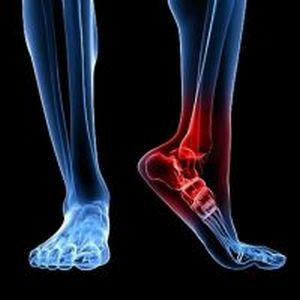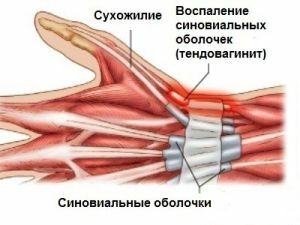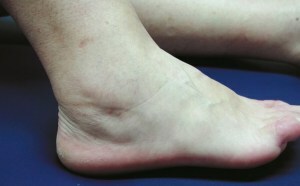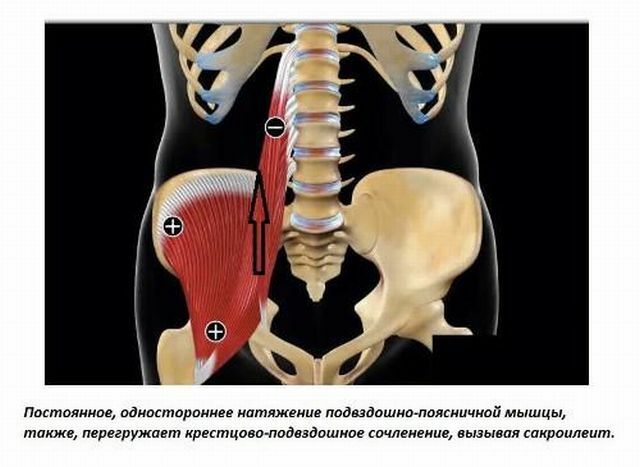 Tendovaginitis is considered quite a dangerous disease, which can lead to necrosis of the tendon and the spread of the inflammatory process throughout the body.
Tendovaginitis is considered quite a dangerous disease, which can lead to necrosis of the tendon and the spread of the inflammatory process throughout the body.
All kinds of damage are caused by this pathology.
Sometimes the disease develops due to increased loads on the tendon. In any case, if symptoms of inflammation of the tendons occur, you should immediately consult a doctor who will choose effective therapy.
Contents of the article
- Who is at risk?
- Causes of inflammation
- Classification by inflammation location
- Symptoms of pathology
- Signs of acute disease
- Chronic course of the disease
- How to stop the disease?
- Large risk of complications
- Preventative measures
Who is at risk?
This term is commonly understood as an inflammatory process that occurs in the synovial membrane of the muscle tendon. This phenomenon is observed quite often. 
In particular, people are exposed to it, who by their activity are forced to repeat the same type of movements many times - knitting, typing on the keyboard, playing musical instruments.
In addition, the appearance of the disease can lead to traumatic injuries.
According to statistics, the lesion of flexor tendons of the limbs is about 32%, whereas the extensor muscles are damaged only in 12% of cases.
Causes of inflammation of
The main factor in the development of nonspecific tenosynovitis is minor damage to the synovium.
They can appear as a result of stretching of muscle tissue, prolonged loads, constant exposure to low temperatures and fatigue.
The cause of the infectious form of the disease is infection by pathogenic microorganisms. So, nonspecific infection can be a consequence of osteomyelitis, panaritium, ulcers, skin cracks.
With the development of a specific process, the causative agents of syphilis or tuberculosis enter the synovial vagina with blood flow.
Sometimes the disease develops as a result of a reactive inflammatory process in arthritis or rheumatism, which are of infectious origin.
Classification according to the location of inflammation
Depending on the localization of the pathological process, a tenosynovitis is isolated:
- Hand .It occurs quite often, since it is the hands that have the maximum load. They are more exposed to injuries and hypothermia.
- Brushes .This type of disease is considered the most common process, and it, as a rule, occurs in musicians, stenographers, etc. Usually pathology is non-infectious and is directly related to professional activity.
- Forearm .This part of the body usually suffers from a creping tendovaginitis. The disease begins with a feeling of aches and fatigue of the hands. There may also appear numbness, burning, tingling. In this case, tendovaginitis is a consequence of prolonged performance of monotonous movements.
- Fingers( De Carven's disease) .Making a correct diagnosis can be difficult. The doctor usually focuses on examining and probing the affected area. Tendovaginitis finger often develops due to infection with a purulent infection.
- Wrists of the .This type of pathology is localized on the backbone. The process affects the tendon, which is responsible for straightening the thumb. The main sign is the appearance of pain in this place.
- Shoulder joint .In this case, there are dull pain in the shoulder area. Most often, this disease is diagnosed in carpenters, grinders, smiths. At a strain of muscles the discomfort is repeatedly amplified, there is an edema.
- Elbow joint .This type of disease is diagnosed rather rarely and is the result of traumatic injury. It is accompanied by painful sensations in the affected areas, creaking, swelling.

- Feet of the .Symptom of this pathology is pain in the area of tendons, which increase during movement. There is also swelling and redness. With the infectious form of the disease, the temperature rises and general deterioration is observed.
- Ankle joint .This pathology is typical for those people who constantly face increased stress on their legs. They include athletes, ballet dancers, etc. Such tendovaginitis can be a consequence of congenital pathologies of the foot.
- of the Knee Joint .This type of disease develops as a result of prolonged stresses on the joint, anomalies in the structure of the body, violation of posture. Sometimes its development is provoked by infection.
- Thighs .To the development of this pathology lead to damage and overload of muscles and tendons. Hip injury is most common in women.
Symptoms of the pathology
Tendovaginitis can occur in acute or chronic form, for each of these diseases there are certain symptoms.
Signs of acute disease
In acute form, there is severe swelling and painful swelling in the affected area. Movements are violated and accompanied by a crunch. An acute process is usually localized in the vagina of the tendons of the feet and hands. Sometimes it touches the fingers of the hand.
With acute tendovaginitis of infectious origin, puffiness is localized in the region of the lower leg and forearm. With a purulent process, the body temperature rises, and chills appear.
An inflammatory fluid is present in the synovial cavity. Blood vessels can also be squeezed, leading to necrosis of the tendon.
Chronic course of the disease
Chronic tendovaginitis of the tendon is usually associated with the profession of man and affects primarily the hands. With this disease, pain occurs when performing active movements, joint mobility is disrupted, and a crunch appears.
The chronic process is usually localized in the area of the flexor and extensor of the fingers.
How to stop the disease?
 The choice of treatment tactics is carried out depending on the nature of the course of the pathological process. Acute tenosynovitis requires the use of general and local drugs. If a person has strong pain, he is injected with novocaine.
The choice of treatment tactics is carried out depending on the nature of the course of the pathological process. Acute tenosynovitis requires the use of general and local drugs. If a person has strong pain, he is injected with novocaine.
If necessary, the doctor may impose a plaster on the affected limb.
In the infectious form of the disease, the pathological process must first be stopped. To do this, use antibacterial drugs and funds to strengthen the immune system.
In the acute form of infectious pathology, the use of non-steroidal anti-inflammatory drugs is indicated.
With the development of a chronic process, warming compresses and exercise therapy are used. No less useful and physiotherapy. The doctor can prescribe UHF, ultrasound, microwave therapy.
Large risk of complications
Tendovaginitis can have different effects on the body. 
Provided that the treatment is correct and timely, the outcome of the pathology may be a temporary loss of the motor activity of the affected area.
In the case of a neglected course, persistent life-long contractures can develop.
Sometimes there is a need for limb amputation.
Therefore, it is so important to diagnose and treat this disease in a timely manner.
Preventive measures
To prevent the development of the disease, you need to properly distribute the load. It is very important to avoid fatigue, exclude traumatic injuries and stretch tendons.
If you have skin injuries or bone structures, you need to treat them in time. Equally important is the observance of hygiene rules - it is very important to keep all parts of the body clean.
In addition, regular exercise is necessary.
If you have the first symptoms of tendovaginitis, you should immediately contact a specialist.
If you do not start treatment of this disease in time, it can lead to the development of extremely negative consequences of , including blood poisoning.
Therefore, it is so important to diagnose in time and clearly follow all medical recommendations.



